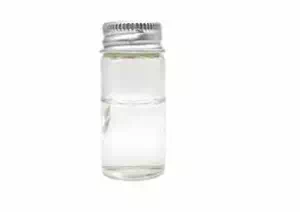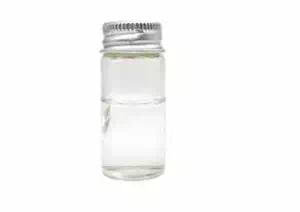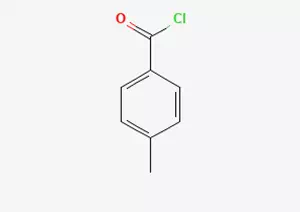All Categories



p-toluoyl chloride CAS 874-60-2, p-toluoyl chloride, CAS 874-60-2
Among the numerous substances in the field of chemistry, p-toluene chlorine, as an important chemical substance, has its unique chemical composition and properties.
CAS : 874-60-2
Formula : C8H7ClO
Mol. wt. : 154.59
EINECS : 212-864-8
Chemical Name | p-Toluoyl Chloride |
Other Name | 4-Methylbenzoicacidchloride; 4-Methyl-benzoylchlorid |
CAS | 874-60-2 |
EINECS | 212-864-8 |
Type | Organic raw materials; Pharmaceutical, pesticide, dye intermediates |
Molecular Formula | C8H7ClO |
Molecular Weight | 154.59 |

Melting point | −57 °C(lit.) |
Boiling point | 48-60 °C(lit.) |
density | 1.257 g/mL at 25 °C(lit.) |
vapor pressure | 5.32 psi ( 20 °C) |
refractive index | n20/D 1.447(lit.) |
Fp | 43 °F |
storage temp. | Refrigerator |
solubility | Miscible with acetone, ethanol, and ether and very soluble in benzene and chloroform (U.S. EPA, 1985) |
form | Liquid |
color | Clear colorless |
explosive limit | 12.8% |
Water Solubility | Miscible with ethanol, ethyl ether, acetone, benzene and chloroform. Immiscible with water. |
Henry’s Law Constant | 10.12 at 30 °C (headspace-GC, Sanz et al., 1997) |
Exposure limits | OSHA PEL: TWA 200 ppm (790 mg/m3); ACGIH TLV: TWA 200 ppm (adopted). |
Stability | Incompatible with oxidizing agents, bases. Stable, but may decompose on exposure to air, moisture or light. Highly flammable. |
Among the numerous substances in the field of chemistry, p-toluene chlorine, as an important chemical substance, has its unique chemical composition and properties. Its molecular formula is clearly defined as C8H7ClO. Through precise chemical calculations, its molecular weight was determined to be 154.5936. From the appearance, p-toluene chlorine presents a white crystalline powder form, which makes it highly recognizable in chemical experiments and industrial production.
This compound possesses a series of specific physical properties. Among them, the density is 1.16. This value reflects the mass characteristics of the substances contained in its unit volume and is of great significance for studying its sedimentation, dispersion and other behaviors in different media. The melting point is -2℃, which means that below this temperature, p-toluene chlorine will remain in a solid state, but when the temperature rises to -2℃ or above, it will gradually melt and transform into a liquid state. This characteristic requires special attention to the temperature conditions during the storage and transportation of the substance. The boiling point is between 225 and 227℃. When the temperature reaches this range, p-toluene chlorine will change from liquid to gas, which is an important reference index in related distillation, separation and other operations. The refractive index is between 1.5525 and 1.5545. This optical property of refractive index can provide an important basis for the identification and analysis of substances. In addition, the flash point is 82℃. The existence of the flash point warns that when the temperature is higher than this, p-toluene chlorine may have a relatively high fire hazard under specific conditions, and corresponding fire prevention measures need to be taken in actual operation.
In the chemical industry and related fields, p-toluenyl chloride has extensive applications. It is often used as an intermediate in the fields of medicine, pesticides, photosensitive materials and dyes, playing an indispensable role in these industries. For example, in pharmaceutical synthesis, it can serve as a key reaction precursor and participate in the construction process of complex drug molecules. In the production of pesticides, it can provide important structural units for the synthesis of pesticide molecules. In the fields of photosensitive materials and dyes, it is also an important intermediate substance for the synthesis of specific functional materials.
The preparation of p-toluenyl chloride is usually achieved by the reaction of pre-treated p-toluenic acid material with thionyl chloride. However, in the actual preparation process, some issues that need attention often arise. Under normal circumstances, the preparation process of p-toluenyl chloride is often accompanied by genotoxic impurities of p-chloromethylbenzoyl chloride. The generation of this impurity is due to the fact that after the chlorination reaction, p-chloromethylbenzoyl chloride will react with other reagents, thereby generating genotoxic impurities. The presence of these genotoxic impurities may pose a potential threat to the safety of the products subsequently produced by applying this substance. Therefore, it is very necessary to strictly control the content of these impurities in p-toluenyl chloride.
Fortunately, through the continuous research and exploration of scientific researchers, high-quality target substances can be obtained by using the preparation methods reported in the literature. Under this optimized preparation method, the content of p-chloromethylbenzoyl chloride can be effectively controlled within 100PPM, and under some more ideal conditions, the optimal content can even be controlled within 10PPM. Meanwhile, the content of other impurities can also be precisely controlled within 0.02%, thus ensuring the quality and safety of p-toluenyl chloride and enabling it to better meet the application requirements of various fields.

P-toluenyl chloride has demonstrated extremely important application value in numerous fields, especially playing an indispensable role in the fields of medicine, pesticides, photosensitive materials and dye intermediates.
In the field of medicine, p-toluenyl chloride is one of the key raw materials in the synthesis process of many drugs. It can participate in the construction of complex drug molecules, introduce specific chemical groups through specific chemical reactions, thereby changing the structure and properties of drug molecules, making them have better efficacy and lower side effects. For example, in the preparation of antigenic formamide human serum albumin, p-toluenyl chloride plays a crucial role. It interacts with other reagents and, through a series of precise chemical reaction steps, gradually builds up the structure of the target drug molecule, ensuring that the final synthesized drug has an accurate chemical composition and good biological activity, providing strong support for medical research and clinical treatment.
In the field of pesticides, p-toluenyl chloride also has extensive applications. It can serve as a key intermediate for synthesizing certain new types of pesticides, helping to develop more targeted, effective and environmentally friendly pesticide products. By reacting with other organic compounds, p-toluenyl chloride can endow pesticide molecules with specific chemical properties, enabling them to perform well in pest and disease control, while reducing the negative impact on the ecological environment and ensuring the sustainable development of agricultural production.
In terms of photosensitive materials, p-toluenyl chloride is also an important component. Due to its unique chemical structure, it can undergo specific chemical reactions under the action of light, thereby altering the optical properties of the material. This characteristic makes p-toluenyl chloride of significant value in the manufacture of photosensitive materials such as photoresistors and photosensitive coatings. It can work in synergy with other photosensitive substances to enhance the photosensitivity and response speed of the material, making it widely applied in the field of optoelectronic information, such as in the manufacture of high-tech devices like optical sensors and image sensors.
In the field of dye intermediates, p-toluenyl chloride is even more indispensable. It can provide abundant chemically active sites for dye molecules. By reacting with other dye precursors, it can synthesize dyes with various bright colors and good dyeing properties. These dyes are widely used in the textile, printing and dyeing and other industries, adding rich and colorful hues to people's lives.
In addition, p-toluenyl chloride also has many special uses in organic synthesis. For instance, it is used as an intermediate for synthesizing (+) -methylene liquid crystals. During this synthesis process, the chemical properties and reactivity of p-toluenyl chloride were fully utilized. Through a series of carefully designed chemical reaction steps, the structure of the liquid crystal molecule was gradually constructed. This liquid crystal material has excellent optical and electrical properties and has broad application prospects in fields such as display technology.
Meanwhile, under the action of mesoporous Zr-TMS catalyst functionalized with trifluoromethanesulfonic acid, p-toluenyl chloride can induce the benzoylation reaction of toluene. During this process, the catalyst interacts with p-toluenyl chloride and toluene to form a specific reaction environment, enabling toluene to smoothly undergo benzoylation with p-toluenyl chloride. This reaction is of great significance for the synthesis of specific organic compounds and provides new ideas and methods for the research and development in the field of organic chemistry.
In addition, p-toluenyl chloride can also be used to impede the 1, 9-diacylation reaction of dipyrrolidine caused by the Grignard reagent 2, 6-diphenylmagnesium bromide. In this reaction, a complex chemical reaction occurs between p-toluenyl chloride and the obstructive Grignard reagent, introducing the acyl chloride group to a specific position on the dipyrrolidine molecule to achieve 1, 9-diacylation. This reaction provides an effective approach for the synthesis of organic compounds with specific structures and properties, and has significant research value in organic synthesis chemistry.
* Prompt reply and 24 hours online, professional team to provide best price and high quality product.
* Sample testing support.
* Every batch of products will be tested to ensureits quality.
*The packing also can be according the customers` requirment.
*Any inquiries will be replied within 24 hours.
*we provide Commerical Invoice, Packing List, Bill of loading, COA , Health certificate and Origin certificate. If your markets have any special requirements, let us know.